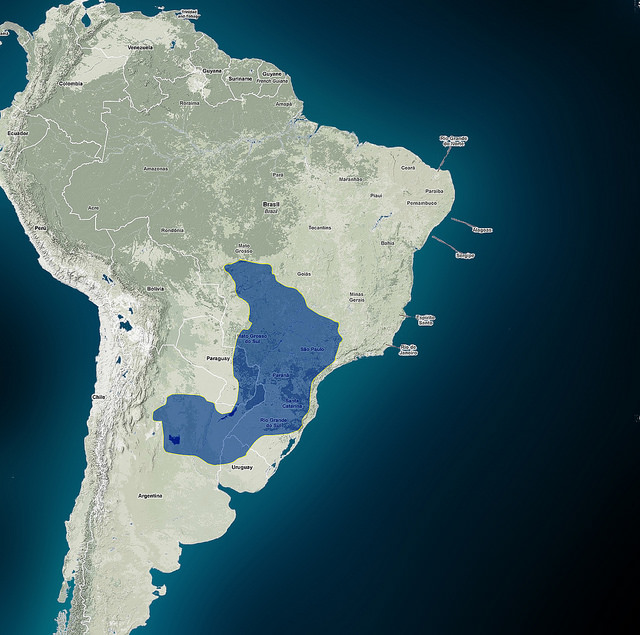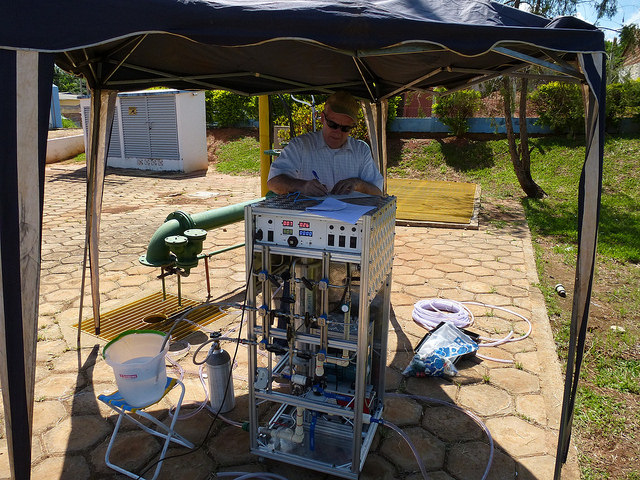
Aquifers, underground water formations that provide water to millions of people around the world, contain water that has filtered there over hundreds of millennia. Using an atom trap built at the U.S. Department of Energy’s Argonne National Laboratory to date the water in a deep South American aquifer, scientists tracked the rate at which helium pooled in the aquifers. The results suggest that helium is trickling into the aquifer from deeper underground, where it is carried to the surface with the flow of water.
The only place where helium is made on Earth is underground, where deep veins of uranium and thorium give off atoms of helium as they decay. This helium eventually makes its way to the surface, where it escapes into the atmosphere and ultimately into outer space.
Geoscientists did not know, however, exactly how this helium gets to the surface. It can filter through rock, but extremely slowly, and the amount of helium in the atmosphere doesn’t match our estimates of how long that would take.
Some scientists have suggested that helium is released from deeper underground during violent tectonic events like earthquakes or even from underwater volcanoes; but others thought groundwater might be a more likely route.
Scientists knew the rate at which helium is naturally produced in the aquifer. They just needed to know how old the water was to calculate how much helium would be naturally created during that time span. If the groundwater carried more helium than the aquifers produced themselves, the source for the extra helium would be further beneath the surface.
Luckily, a group of Argonne researchers led by physicist Zheng-Tian Lu have pioneered a dating technique that uses a very rare isotope called krypton-81. Water picks up this isotope while above ground, but not while below ground; if you know how many atoms of krypton-81 remain in a sample of water, you can tell how long it’s been in the aquifer. And krypton-81 can date much further back than carbon dating—up to a million years or more.
The atom trap uses lasers that vibrate at the exact same frequency as krypton-81 atoms to count individual atoms. (The team has already used it to track how fast aquifers refill and to date ice in glaciers, among other uses).
Hydrologists from the International Atomic Energy Agency and their collaborators collected samples of water from various spots around the Guarani aquifer in South America, a massive reservoir that stretches beneath Argentina, Brazil, Paraguay and Uruguay, and extracted all the dissolved gases. Then the krypton was separated out, and finally the samples came to Argonne to have their krypton-81 atoms counted.
The researchers found much more helium than should have been produced in the aquifer itself during the time the water spent there, which indicates that the helium has been filtering up from below and pooling in the aquifer.
“The difference in helium was a factor of 10—quite significant,” said Argonne physicist Wei Jiang, who coauthored the paper. “This gives us the first solid data for the groundwater scenario.”
According to the paper’s rough estimate, about half of the helium produced in the crust makes its way to the surface via aquifer.
“So the helium in your party balloon has very likely been carried around in groundwater,” Lu said.
Scientists are interested in the global helium cycle because it and other gases are clues to the unseen and mostly mysterious goings-on underneath the Earth’s crust.
The study’s findings are also helpful to understand aquifers, which provide drinking water and irrigation to millions of people around the world, including half the population of the United States.
“The International Atomic Energy Agency works with its international partners to improve our understanding of ground water systems so that we can better protect and manage this vital freshwater resource,” said Pradeep Aggarwal, who led the study.
The work was supported by the Department of Energy’s Office of Science; the development of the krypton-81 dating instrument was supported in part by the National Science Foundation.
The paper, “Continental degassing of helium-4 by surficial discharge of deep groundwater,” appears in the Dec. 1 online edition of Nature Geosciences. The lead author was Pradeep Aggarwal of the International Atomic Energy Agency, as well as IAEA scientists Takuya Matsumoto and Luis J. Araguas-Araguas. Other authors included Argonne physicist Peter Mueller, Reika Yokochi of the University of Chicago, Neil Sturchio of the University of Illinois-Chicago, Hung Chang and Didier Gastmans of the Universidade Estadual Paulista, Roland Purtschert of the University of Bern, and Thomas Torgersen of the National Science Foundation.
Argonne National Laboratory seeks solutions to pressing national problems in science and technology. The nation’s first national laboratory, Argonne conducts leading-edge basic and applied scientific research in virtually every scientific discipline. Argonne researchers work closely with researchers from hundreds of companies, universities, and federal, state and municipal agencies to help them solve their specific problems, advance America’s scientific leadership and prepare the nation for a better future. With employees from more than 60 nations, Argonne is supported by the Office of Science of the U.S. Department of Energy.
The Office of Science is the single largest supporter of basic research in the physical sciences in the United States, and is working to address some of the most pressing challenges of our time. For more information, please visit science.energy.gov.

